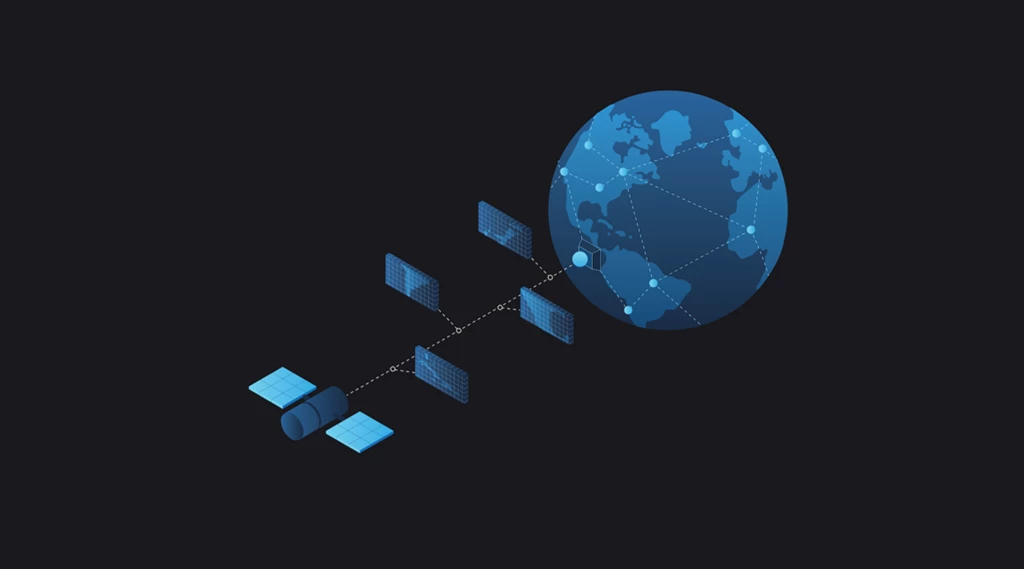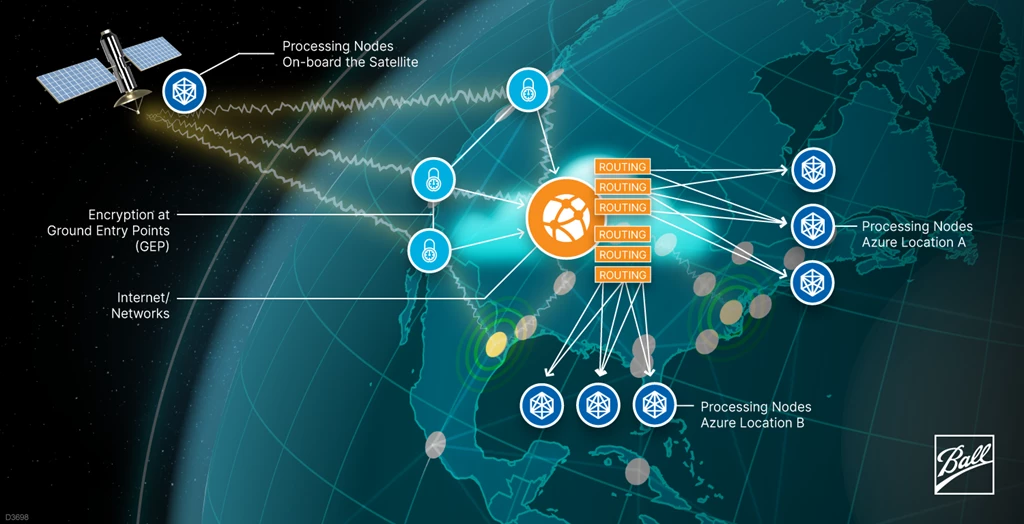Empowering space development off the planet with Azure
Posted on
6 min read

Any developer can be a space developer with Azure. Microsoft has a long history of empowering the software development community. We have the world’s most comprehensive developer tools and platforms from Github to Visual Studio, and we support a wide range of industries and use cases from healthcare, financial services, critical industries, and now space.
As Microsoft expands its focus toward space, we are bringing the power, approachability, and security of our developer story to the next frontier. Microsoft is empowering developers with a platform for on-orbit compute at the ultimate edge, so that spacecraft running AI workloads are connected to the hyperscale Azure cloud.
We are reducing the barriers to entry for space application development and increasing the flexibility and modularity of software solutions. Enabling those building space workloads to easily leverage the productivity of our developer tools and integration with Azure services—to develop, analyze, deploy, and operate space applications in orbit and on the ground.
Today we are bringing new partnerships and capabilities to the development community, including:
- NASA and Hewlett Packard Enterprise (HPE) are testing AI at the ultimate edge for Astronaut Safety.
- New partnerships are bringing development capabilities to on-orbit compute.
- Unlocking new on-orbit climate data applications with Thales Alenia Space (TAS).
- Developing new technologies with Loft Orbital to demonstrate re-taskable satellite functions and seamless connectivity to the terrestrial cloud.
- Demonstrating reconfigurable on-orbit compute and AI processing with Ball Aerospace.
- Rapidly analyzing spaceborne data with the new reference architecture for Azure Orbital with Azure Synapse.
- Empowering analysts with newly integrated Blackshark.ai geospatial models are available with Azure Orbital.
Testing AI for Astronaut Safety at the ultimate edge
Microsoft, NASA, and HPE developed an AI workload test to run on the International Space Station (ISS) that could detect damage to astronaut equipment.
Using Microsoft’s cloud computing platform, NASA and Microsoft created a computer vision application that identifies the condition of the space gloves. Once trained in the cloud, the app was deployed to the HPE Spaceborne Computer-2, an AI-enabled software and hardware platform, aboard the ISS, and then operated at the ultimate edge enabling both local and remote analysis of the glove conditions.
Learn more about this project today.
On-orbit partnerships
Thales Alenia Space unlocks new on-orbit climate data applications with Microsoft to gather unmatched Earth observation insights.

Microsoft is partnering with Thales Alenia Space to demonstrate and validate on-orbit compute technologies with a demonstration onboard the International Space Station (ISS). Thales Alenia Space, a joint venture between Thales (67 percent) and Leonardo (33 percent), is the leader in orbital infrastructures and is developing high-power, edge-computing solutions for space. Microsoft and Thales Alenia Space will deploy a powerful on-orbit computer, an on-orbit application framework, and high-performance Earth Observation sensors to unlock new on-orbit climate data processing applications for the benefit of our planet’s sustainability. In collaboration with Microsoft Research (MSR), Microsoft and Thales Alenia Space will work with research teams in remote sensing, computer vision, and climate science to demonstrate the potential of next-generation on-orbit compute for Earth observation. This space edge computing capacity will allow gathering faster, to-the-point Earth observation insights immediately applicable for our planet’s surveillance, understanding, and protection. This joint collaboration comes a year after the integration of Deeper Vision, an Earth observation data analytics software by Thales Alenia Space, into Azure Space and is a strong milestone towards joint strategic ambitions between Microsoft and Thales Alenia Space which have just signed a Memorandum of Understanding on geospatial solutions, digital ground segment, and space edge computing.
New partnership with Loft Orbital to advance space edge computing and software deployment to orbit.
The Microsoft and Loft Orbital partnership will enable a new way to develop, test, and validate software applications for space systems in Microsoft Azure, and then seamlessly deploy them to satellites in orbit using Loft’s space infrastructure tools and platforms. This solution also offers more efficient paths to flight for modern ‘massless’ payloads, where parties needing space capabilities can leverage shared on-orbit hardware rather than having to build and launch their own.

Working together with Loft, we are bringing core satellite capabilities like tasking which has typically been executed on the ground, to a more agile commanding and tasking paradigm executed on-orbit. To do so, we are integrating the Microsoft Azure suite of products, including terrestrial cloud and ground stations services, with Loft software capabilities that provide access to spacecraft, including on-orbit edge computing environment and sensors.
This strategic partnership will provide government and commercial users with a scalable and simplified capability to deploy software in space, enabling new paradigms in remote sensing, edge compute, on-orbit autonomy, and other areas. This groundbreaking capability will be brought to market first on a jointly used satellite launching in 2023 that will provide a host environment for third-party software applications, enabling users to deploy and operate their applications in orbit.
Demonstrating reconfigurable on-orbit compute processing with Ball Aerospace.

Ball Aerospace, a systems integrator with a heritage of designing and building government satellite programs and mission applications, is planning a series of on-orbit testbed satellites that target the agile implementation of new software and hardware for the US Government. Together, Ball Aerospace and Microsoft are collaborating on the execution of these spacecraft missions to demonstrate reconfigurable on-orbit processing technologies, leveraging the Azure Cloud. This includes the use of containerization and cloud on the edge to enable a software-defined mission approach that embraces standards such as Sensor Open Systems Architecture (SOSA), Universal Command and Control Interface (UCI), and Open Mission Systems (OMS). Modular and reconfigurable on-orbit compute will support multiple complex missions for the United States Government and grant the ability to support future concepts for smaller, agile, multi-mission capabilities across all federal space programs.
Analytics for spaceborne data using Azure Orbital
Satellite imagery is a valuable asset; using AI with satellite imagery is a value multiplier. Using geospatial AI over the same area of interest with regularly refreshed satellite imagery, analysts can monitor change detection for their respective areas of interest.
The use of AI with satellite imagery is a powerful, cost-effective tool spanning all industries that monitor, measure, and/or monetize large areas of the Earth. Extracting this value is hard work as satellite imagery consists of unstructured, big data that requires significant resources to transform and analyze in order to access information and store and use it as structured data.
The Azure Space team released a reference architecture articulating how to apply AI to satellite imagery at scale using Azure resources. This reference architecture makes use of Azure Synapse Analytics, Azure Data Lake Store Gen 2, Apache Spark Pool, Azure Data Share, Azure Batch, and Azure Container Registry. This Azure workflow reduces the complexity of extracting insights from remote sensing data by articulating how to group Azure resources to ingest, store, transform, and apply AI over satellite imagery then use the results for various applications. Azure resources allow for flexibility in the workflow, management of storage options, parallelization of workload, and (re)use of containerized models.

Given Azure’s orchestration flexibility, customers can bring their own imagery. Alternatively, if a customer needs imagery, they can call another imagery provider API specifying the respective area of interest, resolution, and vintage of their choosing through Microsoft’s partner Airbus, Intelligence or Microsoft’s Planetary Computer as an option. Customers can also bring their own trained models into the orchestration. If a customer needs geospatial intelligence and remote sensing AI, Microsoft has partnerships with Blackshark.ai, Orbital Insight, and Esri. For those customers looking to build AI, Microsoft offers tools like Azure Machine Learning and Azure Custom Vision.
Blackshark.ai geospatial models are available for analytics on Azure
Blackshark.ai is offering an end-to-end geospatial platform. Part of this platform is the geospatial analytics service called Orca, which detects objects, and extracts attributes about buildings, vegetation, and a growing number of other detection classes, such as roads or infrastructure in the future. This service is now available through Azure Synapse Analytics.

The containerized Orca service–fully integrated into Azure Synapse Analytics provides fast, global-scale, and accurate insights based on satellite or aerial imagery data sets that are available via Azure or provided by customers. Whenever fresh input data is available, the Orca service can provide precise insights for object and change detection, enabling applications such as efficient 3D mapping services, logistic planning, risk analysis, telecom signal propagation planning, or disaster relief planning. More detailed information about the Orca service is available on the Orca support page.
Learn more
Through our announcements today we are continuing our mission to reduce the barriers to entry to space. We are working closely with our partners to empower and enable developers that are building space workloads to easily leverage the best of Azure services and capabilities to transform their approach to development for space. We’re also working closely with an expanding partner ecosystem to help drive innovation on and off the planet.
Through the combination of cloud and on-orbit space capabilities, new applications are being created and iterated upon even faster which in turn provides original approaches to challenging problems. We look forward to meeting our industry peers to continue this discussion at this week’s Space Symposium.
Learn more about Azure Space today.